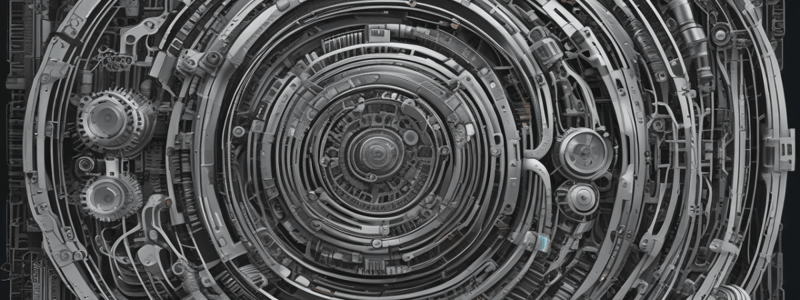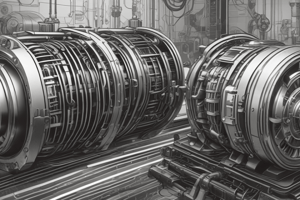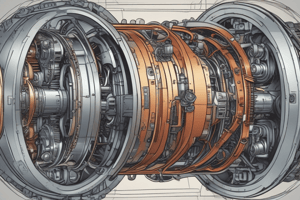Podcast
Questions and Answers
What is the primary method of speed control in induction and synchronous motors?
What is the primary method of speed control in induction and synchronous motors?
- Slip Control
- Supply Voltage Variation
- Frequency Control (using VFDs) (correct)
- Pole Changing
What is the primary advantage of using Variable Frequency Drives (VFDs) for speed control?
What is the primary advantage of using Variable Frequency Drives (VFDs) for speed control?
- Low cost
- High efficiency (correct)
- Coarse speed control
- Simplified implementation
What is the primary drawback of Slip Control for induction motors?
What is the primary drawback of Slip Control for induction motors?
- Low efficiency (correct)
- Limited speed range
- Complexity
- High cost
What is the primary application of Thyristorized stator voltage control in three-phase induction motors?
What is the primary application of Thyristorized stator voltage control in three-phase induction motors?
What is the primary function of the triggering circuit in Thyristorized stator voltage control?
What is the primary function of the triggering circuit in Thyristorized stator voltage control?
What is the primary advantage of Thyristorized stator voltage control over other methods?
What is the primary advantage of Thyristorized stator voltage control over other methods?
What is the primary purpose of the control unit in Thyristorized stator voltage control?
What is the primary purpose of the control unit in Thyristorized stator voltage control?
What is the primary component that provides input voltage to the thyristor bridge converter?
What is the primary component that provides input voltage to the thyristor bridge converter?
What is one of the advantages of thyristorized stator voltage control?
What is one of the advantages of thyristorized stator voltage control?
What is the main principle behind the V/F control method?
What is the main principle behind the V/F control method?
What is the purpose of the DC link capacitor in a VFD?
What is the purpose of the DC link capacitor in a VFD?
What is one of the disadvantages of thyristorized stator voltage control?
What is one of the disadvantages of thyristorized stator voltage control?
What is the main component of a VFD that converts DC back to variable-frequency AC?
What is the main component of a VFD that converts DC back to variable-frequency AC?
What is the advantage of V/F control in terms of motor operation?
What is the advantage of V/F control in terms of motor operation?
What is one of the industrial applications of thyristorized stator voltage control?
What is one of the industrial applications of thyristorized stator voltage control?
What is the purpose of the control unit in a VFD?
What is the purpose of the control unit in a VFD?
What is the primary advantage of slip power recovery schemes in motor drives?
What is the primary advantage of slip power recovery schemes in motor drives?
In what type of applications are slip power recovery schemes commonly used?
In what type of applications are slip power recovery schemes commonly used?
What is a disadvantage of implementing slip power recovery schemes?
What is a disadvantage of implementing slip power recovery schemes?
What is a potential issue with power electronic converters used in slip power recovery schemes?
What is a potential issue with power electronic converters used in slip power recovery schemes?
What is an advantage of regenerative braking in slip power recovery schemes?
What is an advantage of regenerative braking in slip power recovery schemes?
What is a common maintenance concern with slip power recovery schemes?
What is a common maintenance concern with slip power recovery schemes?
What is a potential drawback of slip power recovery systems?
What is a potential drawback of slip power recovery systems?
What is a common application of slip power recovery schemes?
What is a common application of slip power recovery schemes?
What is a key advantage of V/F control in induction motor drives?
What is a key advantage of V/F control in induction motor drives?
What is a limitation of V/F control systems?
What is a limitation of V/F control systems?
What is a common application of V/F control?
What is a common application of V/F control?
What is the primary purpose of slip power recovery schemes?
What is the primary purpose of slip power recovery schemes?
What is the result of the speed difference between the rotor and the synchronous speed of the rotating magnetic field?
What is the result of the speed difference between the rotor and the synchronous speed of the rotating magnetic field?
What is the purpose of adding external resistance to the rotor circuit in Rotor Resistance Control?
What is the purpose of adding external resistance to the rotor circuit in Rotor Resistance Control?
What is a characteristic of Cycloconverter Drive?
What is a characteristic of Cycloconverter Drive?
What is a benefit of slip power recovery schemes?
What is a benefit of slip power recovery schemes?
What is a fundamental aspect of efficiently managing various applications ranging from industrial machinery to household appliances?
What is a fundamental aspect of efficiently managing various applications ranging from industrial machinery to household appliances?
Which type of motor is inherently easier to control?
Which type of motor is inherently easier to control?
What is the effect of increasing the resistance in the armature resistance control method?
What is the effect of increasing the resistance in the armature resistance control method?
What is the advantage of the armature voltage control method?
What is the advantage of the armature voltage control method?
Which method of speed control varies the strength of the magnetic field through which the motor operates?
Which method of speed control varies the strength of the magnetic field through which the motor operates?
What determines the speed of AC motors, especially induction motors?
What determines the speed of AC motors, especially induction motors?
What is the disadvantage of the armature resistance control method?
What is the disadvantage of the armature resistance control method?
Which method of speed control can be achieved through pulse-width modulation (PWM)?
Which method of speed control can be achieved through pulse-width modulation (PWM)?
Flashcards are hidden until you start studying
Study Notes
Speed Control of DC Motors
- Armature Resistance Control:
- Involves adding a variable resistor in series with the armature
- Increases resistance drops more voltage across the resistor, reducing the voltage across the armature, and decreasing the speed
- Simple but less efficient due to power loss in the resistor
- Field Flux Control:
- Varies the strength of the magnetic field through which the motor operates
- Reduces the field current to decrease the magnetic flux, increasing the speed of the motor
- Provides a wide range of speed control but can affect the motor torque
- Armature Voltage Control:
- Varies the voltage applied to the motor's armature
- Done using a variable supply voltage or electronically through pulse-width modulation (PWM)
- Efficient and provides good speed regulation without significant torque loss
Speed Control of AC Motors
- Pole Changing:
- Certain AC motors designed with variable pole numbers that can be selected via wiring configurations
- Changing the number of poles changes the motor's synchronous speed, offering discrete speed options
- Efficient and simple to implement but doesn't allow for continuous speed control
- Supply Voltage Variation:
- For some types of AC motors, varying the supply voltage can influence the speed to a limited extent
- Less effective and rarely used for precise speed control since AC motor speed is more dependent on frequency than voltage
- Frequency Control (using VFDs):
- Variable Frequency Drives (VFDs) adjust the frequency of the power supply to the motor
- Allows for precise speed control and is highly efficient
- Provides smooth control over a wide range of speeds without sacrificing torque
- Slip Control (for Slip Ring Induction Motors):
- Involves controlling the slip of the motor by varying the resistance in the rotor circuit
- Increases the rotor resistance to increase the slip and decrease the motor speed
- Allows for good torque characteristics at lower speeds but is less efficient due to power loss in the external resistances
Thyristorized Stator Voltage Control of 3-Phase Induction Motor
- Principle of Operation:
- Varies the amplitude of the voltage applied to the motor's stator windings by controlling the firing angle of the thyristors
- Adjusts the effective RMS voltage applied to the motor windings, thereby controlling the motor speed
- Circuit Diagram:
- Consists of three-phase AC power supply, three-phase thyristor bridge converter, triggering circuit, control unit, and three-phase induction motor
- Operation:
- Triggering circuit controls the firing of the thyristors in the converter based on the firing angle set by the control unit
- Adjusting the firing angle controls the amplitude of the output voltage applied to the motor
- Smooth and continuous speed control over a wide range
- Advantages:
- Smooth speed control
- High efficiency
- Low starting torque
- Compact and lightweight
- Disadvantages:
- Harmonics generation
- Complex control
- Cost
(V/F) Control Method
- Principle of Operation:
- Maintains the ratio of voltage to frequency (V/F) constant to achieve stable and efficient motor operation
- Allows for precise control of the motor speed without compromising torque characteristics
- Circuit Diagram:
- Consists of AC power supply, rectifier stage, DC link capacitor, inverter stage, control unit, and three-phase AC induction motor
- Operation:
- Rectification: AC power supply is rectified to convert AC to DC
- DC Link: Rectified DC voltage is smoothed using a DC link capacitor
- Inversion: Smoothed DC voltage is inverted back to variable-frequency AC using power electronic switches
- Control: Control unit sets the frequency of the output voltage according to the desired motor speed
- Voltage is adjusted proportionally to maintain the V/F ratio constant
- Advantages:
- Wide speed range
- High efficiency
- Smooth starting and stopping
- Torque control
- Disadvantages:
- Limited overload capacity
- Complex control
- Harmonic generation
- Cost
Slip Power Recovery Schemes
- Principle of Operation:
- Recovers and converts the slip power (power dissipated in the rotor due to slip) into useful electrical energy
- Common Slip Power Recovery Schemes:
- Rotor Resistance Control (Rotor External Resistance Control)
- Static Scherbius Drive
- Cycloconverter Drive
- Advantages:
- Improved efficiency
- Energy savings
- Variable speed control
- Regenerative braking
- Disadvantages:
- Complexity
- Harmonics and power quality issues
- Maintenance
- Cost
Studying That Suits You
Use AI to generate personalized quizzes and flashcards to suit your learning preferences.





